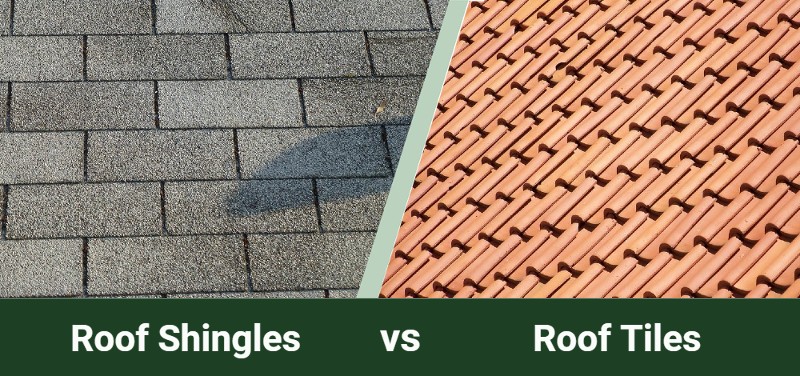Roof Shingles vs Tiles: Differences Explained (With Pictures)
-
Pete Ortiz
- Last updated:

While most homes in the US have shingle roofs, they aren’t the only option. Tiles are one alternative. While tiles tend to be more expensive and harder to replace, they are also longer lasting and provide better protection against bad weather. Although both these types of roofing do perform the same basic tasks, there are differences, and the construction of your home and budget, as well as the look you’re going for, will determine which is the better choice for your home.
Read on to learn more about the differences between these two roofing materials and to see which is the better option for you.
Click Below to Jump Ahead:
Overview of Roof Shingles

Roof shingles are one of the most common roofing materials in the US because they are inexpensive, relatively lightweight, and come in a decent variety of styles and designs. Although they can be made from a variety of materials, asphalt shingles are the most common because of their waterproof capabilities and affordability.
What Are Shingles?
A shingle is a rectangular piece of material that is thin and lightweight. The shingles overlap on the roof so that water passes over them without being able to get into the roof of the property. Asphalt shingles are the most common type, but some are made from other materials, including plastic and fiberglass. They come in a wide variety of shapes, sizes, and finishes to match the design of your home.
Properties
Shingles are lightweight, which means that they can be installed on most properties without fear of damaging the roof or the property structure. It also makes installation easier and potentially less expensive.
Cost is another reason for the popularity of shingles. They are made from less expensive materials than the alternatives and this means that they cost less to purchase. Shingles also have a lower installation cost.
Although they do not have the same long life as tiles, shingles can still last up to 30 years before they need replacing. However, they do need some cleaning and maintenance. Otherwise, the shingles can deteriorate from moss growth.
Installation
Shingles are lightweight and easy to move around. They are also easier to fix to a roof frame, and most homes have a roof that is capable of supporting shingles. The prevalence of shingles means that more companies specialize in their installation and costs are typically lower than with roof tiles.
- Inexpensive
- Lightweight
- Easy and relatively inexpensive to install
- Good variety of materials, styles, and designs to choose from
- Not as long-lasting as tiles
- Fewer designs and styles than tiles
Overview of Tiles

Roofing tiles also come in a wide range of materials, from natural clay to aluminum. They can be shaped or straight, and they tend to boast a longer lifetime than shingles, as well as arguably being more attractive. However, they are heavier and may require some structural modifications to a home, are more expensive, and can become damaged in bad weather.
What Are Tiles?
The most common materials for roofing tiles are clay, concrete, or slate. They overlap, like shingles, but are usually curved in shape, rather than flat. Natural slate tiles are flat, however, and the shape and profile of the tiles depend on the material used and the design you’re looking for.
Properties
Natural tiles are usually made from clay, slate, or sometimes concrete. In all cases, these materials make heavy tiles, and when you install enough tiles to cover an entire roof, you are adding a lot of weight on top of the house. If you are changing from a shingle roof to a tile roof, you will need to have the roof and the house structure assessed to ensure that it can handle the extra weight.
Tile roofs can last up to 100 years, although most manufacturers provide a 50-year guarantee. They do a good job of withstanding extreme weather conditions, as well as debris, although any damage that does occur can be costly to repair. Because they are quite easy to break or crack, it is not always possible to walk on the tiles, which means that any repairs can be more challenging to make. Fortunately, little general maintenance is required for natural tiles, so there shouldn’t be much cause to walk on the roof once installed.
Tiles are more expensive than shingles and installation costs also tend to be higher. If the roof needs to be reinforced before installation, this adds further cost, and buying replacement tiles, if required, will also cost more. However, a lot of these costs are offset by the fact that the tiles can last up to three times as long as shingles.
Installation
Tiles are harder to install, and their weight means that you will likely have to have your roof and property inspected to ensure that they are structurally capable of holding the tile weight. There are also fewer companies capable of installing roof tiles and the difficulty means it takes longer and costs more than with shingles.
- Attractive and luxurious appearance
- Can last up to 100 years
- Stand up well to extreme weather
- Little ongoing maintenance required
- Expensive
- Heavy weight means tiles may need additional structural support
Factors to Consider
Your Climate
The weight of roof tiles means that they withstand wind well. They are unlikely to blow down even in storms. However, it is worth noting that if a tile does blow off the roof, it can be difficult and potentially costly to fix or replace.
Tiles do need treating and sealing if you live in a very wet area, however: otherwise, they can prove too porous and may absorb the water. Similarly, sealing the tiles can help protect against freezing conditions. Extreme heat can negatively impact asphalt shingles, although composite shingles will withstand the heat better. It is a good idea to discuss climatic needs with a roofing company so that they can advise on the best roofing product for your home.

Weight Matters
Shingles, and especially those made with asphalt, are very lightweight. This means that they can be installed on most homes without the need to reinforce the roof structure or the building. And, because most installations are replacing existing shingle tiles, this should be especially true.
Roof tiles weigh a lot more than asphalt and composite tiles. They’re thicker and the natural clay weighs more than asphalt so a tile roof can be several times heavier than a shingle roof. If you’re replacing existing tiles, the roof frame should have been reinforced already. Otherwise, it might be necessary to have additional and potentially costly work done to your home to ensure it can withstand the tiles.
Roof Design
Shingles and tiles come in a range of designs, styles, and colors. You can even get shingles that aim to mimic the look of natural clay tiles. And, because shingles are so commonplace, most people expect to see them on roofs. However, clay tiles have a unique look and if that’s the look you’re going for, it is difficult to exactly replicate the appearance even with high-quality shingles.
Roof Life
Replacing a roof is costly and requires a lot of work, so you want a roof that will last a long time. Shingles will usually last between 15 and 30 years but if you’re looking for real longevity, it is tiles that take it. Most manufacturers guarantee their tile roofing products for 50 years, and some have been known to last as long as a century.
Maintenance
Maintenance requirements for shingles and tiles are similar and the exact requirements will depend on the climate in your area and the general condition of your roof. Both roofs need to be checked regularly for damage and wear and cracked shingles and tiles should be replaced as soon as possible. The biggest difference comes in the fact that clay tiles are usually too brittle to walk on, so maintenance can be more challenging in this respect.
Environmental Consideration
Most shingles are made using asphalt and asphalt is petroleum-based. The manufacture of these tiles is not considered environmentally friendly. Tiles, such as clay tiles, can usually also be recycled and because they last so much longer, they won’t need to be thrown away as often. For these reasons, tiles are usually considered more environmentally friendly than asphalt shingles.
Budget
There are two ways to look at your budget: short-term and long-term. Tiles can cost around five times as much as shingles, including installation costs. But they can also last four or five times longer. Overall, the costs are similar, but you will need to invest a lot more initially if you have tiles fitted.
In Conclusion
Shingles are the most popular type of roofing material in the US, but tiles, including clay and cement tiles, offer a unique look and should last decades longer. They do have higher installation costs, though, and not many homeowners really need a roof that will last 100 years. Although the two do perform the same task, they do so very differently, and we have covered the major differences between these two roof styles above to help you decide which is suitable for your home.
- https://www.fixr.com/comparisons/tile-vs-shingle-roof
- https://americandreamrestoration.com/tile-roofs-shingle-roofs-difference/
- https://plasticinehouse.com/roof-shingles-vs-tiles/
- https://planetpropertyblog.co.uk/tile-roof-vs-shingle-which-type-of-roof-is-best-for-your-home
- https://www.aboutroofing.com/news/roof-shingles-vs-roof-tiles
- https://tileroofing.org/why-tile/durability-longevity/
- https://ajaxgregsontiles.com.au/how-well-do-terracotta-roof-tiles-respond-to-different-weather-conditions.php
Featured Image Credit: (L) Tujunga photo, Shutterstock | (R) gafisher, Pixabay
Contents



